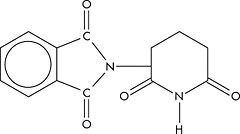Thalidomide: Difference between revisions
imported>Howard C. Berkowitz No edit summary |
imported>Howard C. Berkowitz No edit summary |
||
| Line 8: | Line 8: | ||
Men taking thalidomide also must use contraception, because it is not known if the birth defects can be passed in sperm. | Men taking thalidomide also must use contraception, because it is not known if the birth defects can be passed in sperm. | ||
Patients must not donate blood for at least one year. | Patients must not donate blood for at least one year after discontinuing thalidomide therapy. | ||
It may be prescribed by physicians, and dispensed only by pharmacists, who have approved for a special safety program. <ref>{{citation | It may be prescribed by physicians, and dispensed only by pharmacists, who have approved for a special safety program. <ref>{{citation | ||
Revision as of 15:24, 18 August 2010
Thalidomide is a biological response modifier with an increasing number of applications in severe inflammatory, immune, or dermatologic diseases. It is anti-inflammatory, anti-angiogenic, and immulomodulatory. A piperidinyl isoindole originally introduced as a non-barbiturate hypnotic in the 1950s, it causes extreme fetal malformations or fetal death, and was unavailable for many years. [1]
| Thalidomide is absolutely contraindicated in pregnancy. Female patients who receive it must use two forms of contraception or abstain completely from sexual intercourse.
Men taking thalidomide also must use contraception, because it is not known if the birth defects can be passed in sperm. Patients must not donate blood for at least one year after discontinuing thalidomide therapy. It may be prescribed by physicians, and dispensed only by pharmacists, who have approved for a special safety program. [2] |
|---|
Physicians are cautiously approaching it for a number of disorders.[3] Even though its mechanisms have not been fully characterized, it has a number of unique features.[4]
Indications
It was reintroduced for the narrow indication of preventing and treating severe skin reactions in leprosy, and for multiple myeloma. Approved usages as an orphan drug extended to AIDS wasting syndrome, prevention and treatment of severe recurrent aphthous stomatitis in severely, terminally immunocompromised patients; prevention and treatment of graft-versus-host disease in patients receiving bone marrow transplantation; treatment of clinical manifestations of both tuberculous and nontuberculous mycobacterial infection; treatment of Crohn’s disease; and treatment of primary brain tumors.
In addition, thalidomide has been used for the treatment of a variety of inflammatory and/or dermatologic disorders, treatment of various HIV-associated conditions, and treatment of various malignancies. [5]
It has been used in Behcet's Syndrome.[6]
Pharmacology
While all of its mechanisms are not fully understood, its functions include:[7]
- immunomodulator for tumor necrosis factor-alpha
- costimulatory or adjuvant effect on T-lymphocytes resulting in increased T-cell proliferation and increased production of interleukin-2 and interferon gamma
- modulation of leukocyte migration and chemotaxis.
- Possible suppression of macrophage involvement of prostaglandin synthesis and modulation of interleukin-10 and interleukin-12 production by peripheral blood monocytes.
While its anti-inflammatory and immunomodulatory effects are complex, they appear different from those of other agents, including corticosteroids, cyclosporin (e.g., cyclosporine) or macrolide (e.g., tacrolimus) immunosuppressants, pentoxifylline, immunosuppressive purine analogs (e.g. azathioprine) and purine metabolism inhibitors (e.g., mycophenolic acid), and Non-steroidal anti-inflammatory agents.
It does not appear to interfere with antimicrobial defense mechanisms, lymphocyte proliferation, granuloma formation, and delayed hypersensitivity reactions.
References
- ↑ Anonymous (2025), Thalidomide (English). Medical Subject Headings. U.S. National Library of Medicine.
- ↑ Thalidomide, National Toxicology, U.S. Department of Health and Human Services
- ↑ "Fresh start for notorious drug", BBC News, 17 July 1998
- ↑ Gordon JN, Goggin PM (2003), "Review: Thalidomide and its derivatives: emerging from the wilderness", Postgrad Med J 79: 127-132, DOI:10.1136/pmj.79.929.127
- ↑ Monograph: Thalidomide — Uses, American Society of Health System Pharmacists/Medscape
- ↑ George E. Ehrlich (15 March 1998), "Editorial: Behcet Disease and the Emergence of Thalidomide", Ann Intern Med 128 (6): 494-495
- ↑ Monograph: Thalidomide — Pharmacology, American Society of Health System Pharmacists/Medscape
